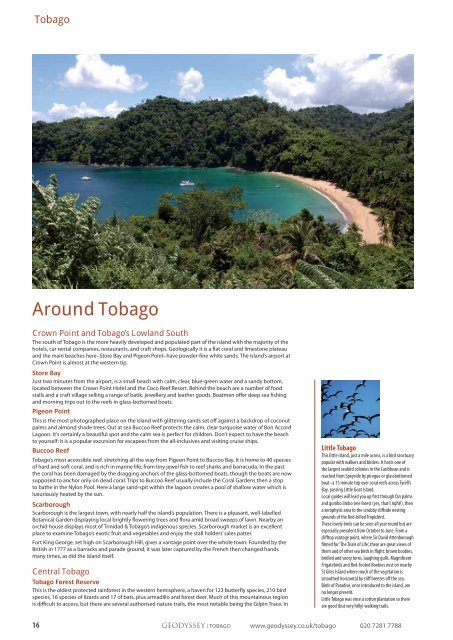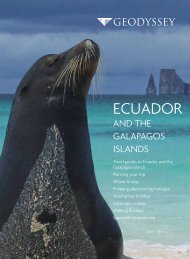You also want an ePaper? Increase the reach of your titles
YUMPU automatically turns print PDFs into web optimized ePapers that Google loves.
<strong>Tobago</strong><br />
Around <strong>Tobago</strong><br />
Crown Point and <strong>Tobago</strong>’s Lowland South<br />
The south of <strong>Tobago</strong> is the more heavily developed and populated part of the island with the majority of the<br />
hotels, car rental companies, restaurants, and craft shops. Geologically it is a fl at coral and limestone plateau<br />
and the main beaches here–Store Bay and Pigeon Point–have powder-fi ne white sands. The island’s airport at<br />
Crown Point is almost at the western tip.<br />
Store Bay<br />
Just two minutes from the airport, is a small beach with calm, clear, blue-green water and a sandy bottom,<br />
located between the Crown Point Hotel and the Coco Reef Resort. Behind the beach are a number of food<br />
stalls and a craft village selling a range of batik, jewellery and leather goods. Boatmen off er deep sea fi shing<br />
and morning trips out to the reefs in glass-bottomed boats.<br />
Pigeon Point<br />
This is the most photographed place on the island with glittering sands set off against a backdrop of coconut<br />
palms and almond shade trees. Out at sea Buccoo Reef protects the calm, clear turquoise water of Bon Accord<br />
Lagoon. It’s certainly a beautiful spot and the calm sea is perfect for children. Don’t expect to have the beach<br />
to yourself: it is a popular excursion for escapees from the all-inclusives and visiting cruise ships.<br />
Buccoo Reef<br />
<strong>Tobago</strong>’s most accessible reef, stretching all the way from Pigeon Point to Buccoo Bay. It is home to 40 species<br />
of hard and soft coral, and is rich in marine life, from tiny jewel fi sh to reef sharks and barracuda. In the past<br />
the coral has been damaged by the dragging anchors of the glass-bottomed boats, though the boats are now<br />
supposed to anchor only on dead coral. Trips to Buccoo Reef usually include the Coral Gardens then a stop<br />
to bathe in the Nylon Pool. Here a large sand-spit within the lagoon creates a pool of shallow water which is<br />
luxuriously heated by the sun.<br />
Scarborough<br />
Scarborough is the largest town, with nearly half the island’s population. There is a pleasant, well-labelled<br />
Botanical Garden displaying local brightly fl owering trees and fl ora amid broad sweeps of lawn. Nearby an<br />
orchid house displays most of <strong>Trinidad</strong> & <strong>Tobago</strong>’s indigenous species. Scarborough market is an excellent<br />
place to examine <strong>Tobago</strong>’s exotic fruit and vegetables and enjoy the stall holders’ sales patter.<br />
Fort King George, set high on Scarborough Hill, gives a vantage point over the whole town. Founded by the<br />
British in 1777 as a barracks and parade ground, it was later captured by the French then changed hands<br />
many times, as did the island itself.<br />
Central <strong>Tobago</strong><br />
<strong>Tobago</strong> Forest Reserve<br />
This is the oldest protected rainforest in the western hemisphere, a haven for 123 butterfl y species, 210 bird<br />
species, 16 species of lizards and 17 of bats, plus armadillo and forest deer. Much of this mountainous region<br />
is diffi cult to access, but there are several authorised nature trails, the most notable being the Gilpin Trace. In<br />
16<br />
Little <strong>Tobago</strong><br />
This little island, just a mile across, is a bird sanctuary<br />
popular with walkers and birders. It hosts one of<br />
the largest seabird colonies in the Caribbean and is<br />
reached from Speyside by pirogue or glassbottomed<br />
boat–a 15 minute trip over coral reefs across Tyrell’s<br />
Bay, passing Little Goat Island.<br />
Local guides will lead you up fi rst through fan palms<br />
and gumbo limbo tree forest (yes, that’s right!), then<br />
a xerophytic area to the scrubby cliff side nesting<br />
grounds of the Red-billed Tropicbird.<br />
These lovely birds can be seen all year round but are<br />
especially prevalent from October to June. From a<br />
cliff top vantage point, where Sir David Attenborough<br />
fi lmed for ‘The Trials of Life’, there are great views of<br />
them and of other sea birds in fl ight: brown boobies,<br />
bridled and sooty terns, laughing gulls. Magnifi cent<br />
Frigatebirds and Red-footed Boobies nest on nearby<br />
St Giles Island where much of the vegetation is<br />
smoothed horizontal by stiff breezes off the sea.<br />
Birds of Paradise, once introduced to the island, are<br />
no longer present.<br />
Little <strong>Tobago</strong> was once a cotton plantation so there<br />
are good (but very hilly) walking trails.<br />
GEODYSSEY | TOBAGO www.geodyssey.co.uk/tobago 020 7281 7788



